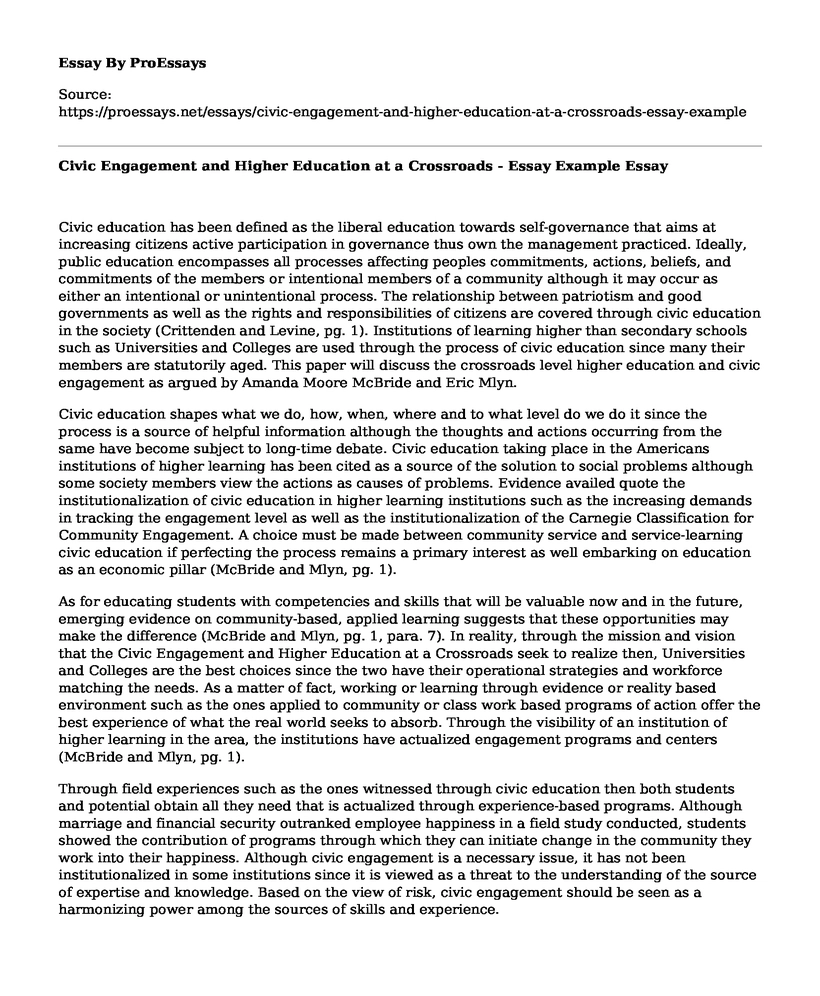Civic education has been defined as the liberal education towards self-governance that aims at increasing citizens active participation in governance thus own the management practiced. Ideally, public education encompasses all processes affecting peoples commitments, actions, beliefs, and commitments of the members or intentional members of a community although it may occur as either an intentional or unintentional process. The relationship between patriotism and good governments as well as the rights and responsibilities of citizens are covered through civic education in the society (Crittenden and Levine, pg. 1). Institutions of learning higher than secondary schools such as Universities and Colleges are used through the process of civic education since many their members are statutorily aged. This paper will discuss the crossroads level higher education and civic engagement as argued by Amanda Moore McBride and Eric Mlyn.
Civic education shapes what we do, how, when, where and to what level do we do it since the process is a source of helpful information although the thoughts and actions occurring from the same have become subject to long-time debate. Civic education taking place in the Americans institutions of higher learning has been cited as a source of the solution to social problems although some society members view the actions as causes of problems. Evidence availed quote the institutionalization of civic education in higher learning institutions such as the increasing demands in tracking the engagement level as well as the institutionalization of the Carnegie Classification for Community Engagement. A choice must be made between community service and service-learning civic education if perfecting the process remains a primary interest as well embarking on education as an economic pillar (McBride and Mlyn, pg. 1).
As for educating students with competencies and skills that will be valuable now and in the future, emerging evidence on community-based, applied learning suggests that these opportunities may make the difference (McBride and Mlyn, pg. 1, para. 7). In reality, through the mission and vision that the Civic Engagement and Higher Education at a Crossroads seek to realize then, Universities and Colleges are the best choices since the two have their operational strategies and workforce matching the needs. As a matter of fact, working or learning through evidence or reality based environment such as the ones applied to community or class work based programs of action offer the best experience of what the real world seeks to absorb. Through the visibility of an institution of higher learning in the area, the institutions have actualized engagement programs and centers (McBride and Mlyn, pg. 1).
Through field experiences such as the ones witnessed through civic education then both students and potential obtain all they need that is actualized through experience-based programs. Although marriage and financial security outranked employee happiness in a field study conducted, students showed the contribution of programs through which they can initiate change in the community they work into their happiness. Although civic engagement is a necessary issue, it has not been institutionalized in some institutions since it is viewed as a threat to the understanding of the source of expertise and knowledge. Based on the view of risk, civic engagement should be seen as a harmonizing power among the sources of skills and experience.
As for engaged scholarship, the pursuit of knowledge is increasingly more about innovations that create social change than it is knowledge for knowledges sake (McBride and Mlyn, pg. 1, para. 9). The scholarship is meant towards increasing the level of engagement impact through studies that in addition to solving social problems they add to the existing stock of knowledge. Although the scholarship approach to increased civic education impact seems worthy, it has been challenged by personal faculty autonomy and freedom in academics as well as limited knowledge in partnership creation and the process of rolling the research projects (McBride and Mlyn, pg. 1).
In conclusion, it can be noted that civic education cannot solve all the challenges facing the institutions of higher learning and the society in general, they can solve many issues. Increased investment at higher institutional level can see increased realization of solutions to social problems both in the present-day and for the future.
Works Cited
Crittenden, Jack, and Peter Levine. "Civic Education". Plato.Stanford.Edu, 2013, https://plato.stanford.edu/entries/civic-education.
McBride, Amanda Moore, and Eric Mlyn. "Civic Engagement And Higher Education At A Crossroads". Huffpost, 2013, http://www.huffingtonpost.com/amanda-moore-mcbride/civic-engagement-and-higher-education_b_4218389.html.
Cite this page
Civic Engagement and Higher Education at a Crossroads - Essay Example. (2021, Jun 22). Retrieved from https://proessays.net/essays/civic-engagement-and-higher-education-at-a-crossroads-essay-example
If you are the original author of this essay and no longer wish to have it published on the ProEssays website, please click below to request its removal:
- Difficulties Associated with Teaching the Novel to Young Students. Essay Exampe.
- Child Welfare Social Work Students Annotated Bibliography
- Negative and Positive Factors That Affect the Well-Being of the LGBTQ Youth Paper Example
- Spirituality and Ethics of Human Cloning Essay Example
- Paper Example on Young Adults in Stress: The Impact of the Stressor
- Gaining Compliance Through Effective Organizational Communication - Essay Sample
- Relationship Between Listening and Interpersonal Communication - Paper Sample







